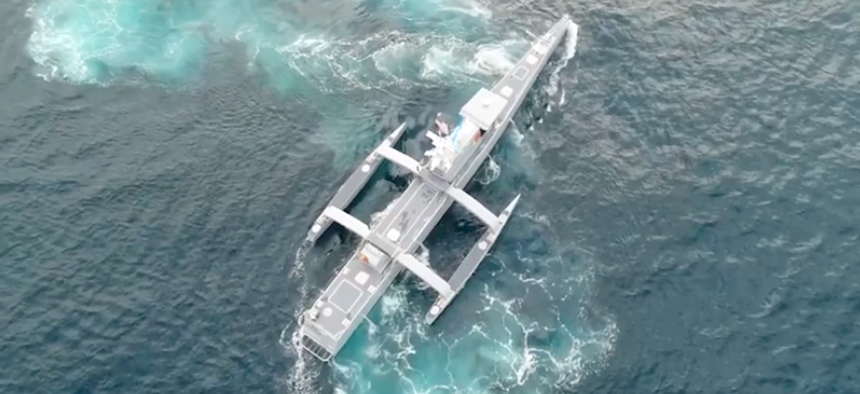sponsor content What's this?

Leidos
An Inside Look at the Autonomous Vessels Changing Warfighting
Sea Hunter, the first unmanned surface vessel of its kind, is one indication of how USVs can integrate systems, sensors and data collection to lower costs and minimize risks in hostile environments.
Presented by
Leidos

Over the past year, the execution of long-duration Unmanned Surface Vehicle (USV) missions has begun to define a new era in warfighting. The Office of Naval Research’s (ONR) Medium Displacement Unmanned Surface Vessel (MUSV), Sea Hunter, in December 2018 became the first ship to successfully navigate the 4,000-nautical mile round trip journey from San Diego to Hawaii and back without a single crew member on board — publicly demonstrating its ability to host and use advanced sensors and artificial intelligence tools. The Leidos-designed 132-foot-long vessel proved that enhancements to future autonomous warfighting vessels will translate to lower costs, reduced manpower requirements and a reduction in the number of times warfighters have to put themselves in harm’s way.
“Driving a ship in the maritime military environment is not like driving a car. There are no lanes, curbs or green lights. There is more freedom to maneuver and freedom in interpretation, which can lead to increased risk of collision,” says Dan Brintzinghoffer, the vice president of maritime business development at Leidos, noting that advanced USVs can provide the platform that can carry a wide range of payloads for multiple maritime missions, including, anti-submarine warfare, electronic warfare and logistics.
New underwater and surface unmanned vessels can go into forward areas and collect valuable and pertinent data without crew members onboard.
“We can reduce the cost and risk of that mission,” says Dr. Tim Barton, the Chief Technology Officer of the Leidos Defense Group. “Getting soldiers, sailors, Marines, the Coast Guard and citizens out of harm's way has a big impact when you’re calculating costs, because every warfighter is factored into those costs.”
As a result, ONR and Defense Advanced Research Projects Agency autonomy efforts have centered themselves around this idea that new, flexible and contextually adaptable autonomous systems provide intelligence teams and warfighters with a competitive edge on the battlefield.
“Autonomous vehicles, first and foremost, give the warfighter more informative battleground coverage through critical intelligence, surveillance and reconnaissance nodes,” says Brintzinghoffer, noting that this is where the Navy is headed with its Medium Unmanned Surface Vehicle (MUSV) and Large Unmanned Surface Vehicle (LUSV) programs that aim to augment the Navy’s manned surface forces with high-endurance and self-deploying vessels to expand U.S. Navy reach. “As ships spread out across the ocean, their systems are able to extend military communications, naval line of sight, and battlefield intelligence collection in an unprecedented way.”
AI-Backed USVs Offer a New Way to Take on “Dull, Dirty and Dangerous” Missions
The long-haul AI-backed Sea Hunter is designed to support “dull, dirty and dangerous” missions, says Brintzinghoffer. “It allows the military to complete the more monotonous missions or dangerous missions without putting people in harm’s way.”
The ships’ AI-fed systems and ability to collect, analyze and communicate data points in real-time lessen the load on network infrastructure and manual analytics operators, which can reduce high-stress situations while also improving information accuracy. Sensor-collected data combined with artificial intelligence and machine learning helps ships like Sea Hunter avoid collisions and abide by International Regulations for Preventing Collisions at Sea (COLREGs). Meanwhile, an automatic identification system (AIS) brings this sensor and radar data together to identify position, course and speed, ultimately enabling more efficient communication between ships at sea.
Further, AI-backed USVs are able to automatically validate AIS information. Previously, crew members had to interpret images from onboard cameras. With AI at the helm, the human-trained cameras and systems on board can recognize boats and their movements, cutting down blind spots and human error. The USV can then act on this information, enabling the ship or boat to steer itself without human intervention.
For example, these trained systems can keep ships operating after sundown. “All the ships at sea use specific lighting configurations,” says Brintzinghoffer. “Machines can recognize those lighting configurations once you teach the machine what that means, and then correlate that information to a radar contact. This significantly enhances the operators’ situational awareness.”
USVs Cost-Effectively Boost Flexibility, Adaptability
In addition to improving situational awareness, AI-backed systems integrated into USVs significantly lessen the overall life cycle cost of a ship by reducing operator workload and increasing mission endurance.
An analysis performed by Johns Hopkins Applied Physics Laboratory estimated the daily cost of operating a Sea Hunter to be $15,000 to $20,000 versus the $700,000 per day cost of operating a manned destroyer.
“Unmanned vessels can conduct intelligence and reconnaissance far more cost effectively than a 300-person destroyer,” says Dr. Barton. Moreover, autonomous ships don’t have to be built from scratch: Engineers can retrofit existing ships with autonomous capabilities to reduce crew costs and risk, and use existing ship infrastructure.
“Keeping the dangerous elements of the warfighting environment in mind, you want to reduce the number of people involved and enhance the situational awareness,” says Brintzinghoffer. “With companies like Leidos introducing autonomy as another tool to bring to the fight, commanders can modify operations for safer, more expansive missions.”